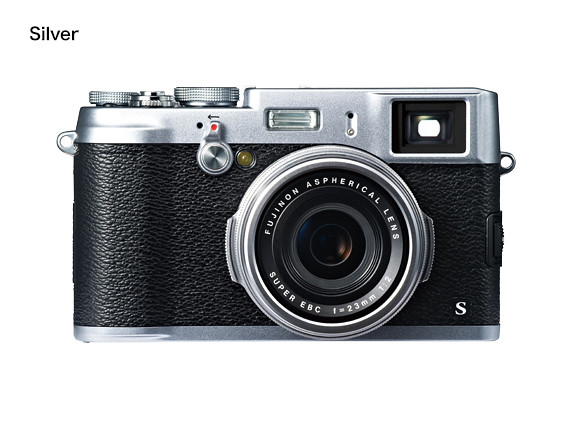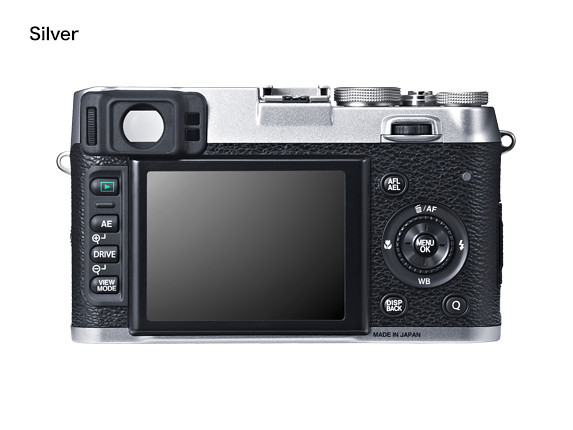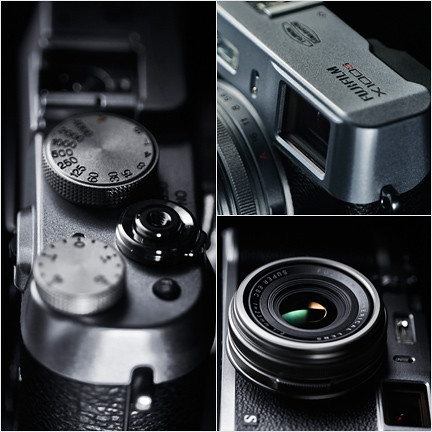If you like this post, help us share it
First, Happy New Year and I hope everyone had a brilliant start of the new year. This is my first post in 2013 and I am very much looking forward to what camera manufacturers have for us in 2013. Thank you for your continual support to this blog.
Amongst the many new cameras that going to be announce during 2013 CES, the Fujifilm X100s is the most interesting one. Fujifilm makes some of the most amazing, classical look mirrorless cameras. It already has a very strong line up of mirrorelss with the X10, X100, X-E1 and X-Pro 1. Their retro, classical look of the cameras praises by many enthusiast and you know we all want a good looking camera.
The Fujifilm X100s is available to order from B&H.
The Fujifilm X100 in the past has impressed by many, but there are some sluggishness that are equally annoying, such as the slow start time, average AF and MF speed. With the newly announced X100s, Fujifilm has done a lot of work to build upon the strengths of its predecessors, as well as improving the responsiveness of the camera. The new Fujifilm X100s remains a fixed lens camera equipped with the brilliant FUJINON 23mm f/2.

The Fujifilm X100s up sized its sensor to a 16.3MP APS-C X Trans CMOS II sensor and together with its EXR Processor II, it promises to producing comparable high resolution images to those taken on full frame sensors. The X100s like the X-PRO 1 does not have a low pass filter, instead it carries a unique color filter arrangement which allows for the removal of the low pass filter to improve image sharpness, yet minimising moire pattern appearing.

In the past, the X100 has issues with its slow auto focusing and general responsiveness of the camera, these hopefully are the past because the newly-developed X-Trans CMOS II sensor has built-in Phase Detection pixels which Fujifilm claims the X100S is the world’s fastest AF mirrorless camera (0.08 seconds). Additionally, the EXR Processor II offers very speedy response times with a start-up time of approx. 0.5 seconds, plus with its shutter time lag of only 0.01 seconds.

Also the Fujifilm X100S had incorporated a new “Digital Split Image” feature, which displays dual images on the left and right to be lined up for manual focusing. This enables accurate focusing especially when working with an open aperture or macro shooting. A Focus Peak Highlight function is also added, which shows you precisely which area of your composition is in focus. In my opinion, I find the focus peak highlight function annoying and have always switched it off.
What do I think of the new X100s? The X100s is surely a very nice looking camera, its retro classical look is its unique selling point. Most enthusiasts will buy it probably because of its classical look. To be honest, we are not looking for a high performance camera, otherwise we would choose a DSLR. When we choose a mirrorless, we are most likely looking for something that is easy to travel/carry, yet still gives us an adequate overall performance. This is a subjective matter and that’s why we have the X10, X100, X-E1 and X-Pro 1 to choose from. The improved AF and MF system on the X100s will certainly fix the shortcomings of its predecessor, so hopefully we can expect a reasonably speedy camera. In terms of image quality, it is safe to say that any APS-C based mirrorless are capable of producing very good image quality. This really leaves four things to consider when choosing this camera, 1) the price, 2) the size, 3) the look and 4) does a fixed lens 35mm f/2 suit your purpose.
Here is a summary of the main features:
(1) Sensor performance comparable to full-frame output
The X100S features FUJIFILM’s newly-developed 16.3 megapixel APS-C X-Trans CMOS II sensor with a unique, highly randomised, colour filter arrangement. The benefit of the new array is the elimination of the need for an optical low-pass filter; these are used in conventional sensors to reduce false colour and moiré effects but they also reduce image resolution. The removal of the optical low-pass filter allows the X-Trans CMOS II sensor to maximise the light it receives directly, enabling users to capture much finer detail and optimise resolution levels.
The X100S uses a Lens Modulation Optimiser to reduce optical effects such as lens diffraction, which occurs when light passes through a lens. Even when stopped down to f/16, the X100S retains sharpness and texture in the smallest details, demonstrating the extent of the sensor and lens combination’s capabilities, perfectly.
The excellent sensitivity of the X-Trans CMOS II sensor is coupled with the new EXR Processor II’s advanced signal processing capacity, which can reduce noise by more than 30% (*2) compared to its predecessor. Even when shooting in low-light, at a high ISO setting, the FUJIFILM X100S will produce crisp images with minimal grain.
(2) The World’s fastest Auto Focus and High-speed EXR Processing
With built-in Phase Detection, the X100S offers the world’s fastest AF speed of just 0.08 seconds(*1). The Intelligent Hybrid AF can switch to Contrast AF, dependent on the demands of the subject or scene, to ensure that the camera always auto-focuses quickly and with precision.
The EXR Processor II delivers processing speeds twice that of FUJIFILM’s previous generation processor (*6). The fast responses result in an impressive start-up time of approx. 0.5 seconds (*4), and a shooting interval of 0.5 seconds. In addition the X100S delivers a burst shooting rate of up to 6 frames per second (max. 29 frames) at the full resolution of 16.3 megapixels and the shutter time lag is a mere 0.01 seconds.
(3) Enhanced manual focus performance with the world’s first (*5) ‘Digital Split Image’ display
Making use of the built-in phase detection pixels for AF action, the X100S is the world’s first (*5) camera to offer a “Digital Split Image” feature, which displays dual images on the left and right to be lined up for manual focusing. This enables accurate focusing especially when working with an open aperture or macro shooting.
In addition, the X100S offers a handy Focus Peak Highlight function, which emphasises the outline of the subject focus plane. It provides the photographer with a guide, even in situations where it is difficult to calculate focusing accuracy, allowing users to enjoy manual focusing comfortably, however challenging the conditions.
(4) Premium Hybrid Viewfinder for easy image composition
Offering users freedom when composing photos and adaptability for a range of shooting conditions, the X100S’s Hybrid Viewfinder combines both an Optical and an Electronic Viewfinder.
The electronic viewfinder uses a 100% coverage, extra high resolution, 2,360K-dot High Definition LCD panel. It shows depth-of-field during macro shooting, as well as white balance settings, allowing users to accurately compose their shot while continuously looking through the viewfinder.
The premium quality optical viewfinder offers an easy-to-see magnification of 0.5 at a 23mm focal length and a horizontal apparent field of view of 26 degrees. The all-glass construction uses high-refractive index glass to minimise chromatic aberrations and distortion.
While in the optical viewfinder mode, users can make adjustments to shutter speed, aperture, ISO and other settings without having to take their eye off the viewfinder. The shooting frame (Bright Frame) and text brightness automatically adjust according to the ambient light available, to ensure that the information on the display is easy to see at all times.
The system features an OVF Power Save mode, which activates the power-saving function in the optical viewfinder mode to double the maximum number of images per full charge from 300 (*7) in normal operation.
With FUJINON’s proprietary coating, the viewfinder cleverly resists fingerprints and can easily be wiped clean, so that users can enjoy the optical viewfinder’s clear display without compromise.
(5) FUJINON 23mm f/2 lens offering premium image quality in a compact body
Specifically designed for this model, the FUJINON 23mm f/2 Single Focal Length Lens has a fixed angle of incidence of light into the lens, which facilitates optimum optical design. Taking full advantage of this, the X100S demonstrates advanced levels of image clarity, not only in the centre of the image, but also through to the edges of the photo. The versatile focal length of 35mm (*8) delivers an angle of view ideal for a diverse range of subjects and scenes.
The lens consists of 8 elements in 6 groups, and includes a high-performance double-sided aspherical element and highly-refractive converging glass elements, which deliver a high level of detailed performance with minimal aberration, excellent sharpness and beautiful colour reproduction. Moreover, FUJINON’s proprietary HT-EBC coating is applied to effectively control image flares and ghosting.
Other benefits of this lens are the beautiful, soft, round-shaped Bokeh that is produced from the 9 blade lens diaphragm. In addition the lens allows you to get as close as 10cm from your subject in macro mode for stunning close-up shots. And its built-in 3-stop ND filter enables blurring of the background in portraits, or applies a gorgeous creamy look to flowing water even in a bright setting.
(6) Elegant design and sophisticated functionality
The front of the X100S proudly bares the letter “S” as confirmation of its extensive evolution from the FUJIFILM X100. Down to the tiniest detail, the premium build and feel of the X100 is continued in the X100S. FUJIFILM’s top quality Japanese engineering is evident from the high precision components used and the perfectly optimised body.
The X100S’s top and base parts are made of magnesium alloy to achieve a lightweight, resilient, yet delicate design. A specially-formulated coating is applied to give its surface a steel look for an added premium feel. All the dials and rings have been milled from solid metal, with attention paid to the finer details such as finger grips and enhanced operability. The exterior is finished with synthetic leather, which is durable and resilient to the environment yet reproduces the texture of real leather, while still offering the practical benefits of additional grip and comfort.
The layout of the dials and rings allow users to operate the aperture ring on the lens with their left hand, and the shutter speed dial and exposure compensation dial on the top panel with their right hand, meaning all the settings can be adjusted comfortably without having to take your eye off the viewfinder. And to make you feel even more at home, you can even customise your shutter sound by choosing between the four different sounds available: Lens Shutter, Focal Plane Shutter, Mirror Up and Silent Shutter.
The menu system has been also updated to incorporate a Q “Quick” button which allows you to quickly call up frequently-used menu items such as ISO setting and Film Simulation modes. In addition, the Fn (Function) button allows users to assign functions frequently used while shooting, for convenient use at the touch of a button.
(7) Artistic photography
The X100S features FUJIFILM’s proprietary ‘Film Simulation Modes’. Users can choose from ten simulation options which replicate the results achieved by FUJIFILM colour reversal films (Velvia / PROVIA / ASTIA), professional colour negative films (PRO Neg. Std / PRO Neg. Hi), monochrome filters (MONOCHROME, Ye filter, R filter and G filter) and SEPIA.
Also available on the X100S is the Advanced Filter function; users can choose from 8 different artistic effects which can be previewed on the LCD screen:
Pop Colour – great for boosting contrast and colour saturation
Toy Camera – create shaded borders as if you were taking a photo on a toy camera
Miniature – adds top and bottom blur for a diorama or miniature effect
Dynamic Tone – create a fantasy effect by dynamically-modulated tonal reproduction
Partial Colour – highlights one colour and leaves the rest of the image in black and white (choose from red, orange, yellow, green, blue or purple)
High Key – enhances brightness and reduces contrast to lighten tonal reproduction
Low Key – create uniformly dark tones with few areas of emphasised highlights.
Soft Focus – blurs the focus of the image edges to create a softer effect
In addition a Multiple Exposure function enables users to combine two separate images together for special creative effects. And for greater artistic freedom, the aspect ratio can be selected from 3:2, 16:9, and 1:1 (square) to accommodate a wide range of photographic styles.
(8) Full HD Video Shooting
The X100S can shoot at 60fps during Full HD video recording (1920 x 1080) for very smooth video capture. Plus shooting at the high bit-rate of 36Mbps will result in reduced noise and enhanced image quality that reveals every detail, from individual leaves in the trees, to subtle changes in facial expression. During video recording, users have access to many of the additional modes available in still image capture. Film Simulation modes can be used, White Balance settings can be adjusted, you can even make the most of the fast lens to produce beautiful bokeh and also operate the Intelligent Hybrid AF for high-speed and high-precision focusing.
Where can I find the equipment seen on this site?
If you find this site useful and planning to purchase any of the equipment seen on this site, please show your support by purchasing your photo equipment at B&H Photo Video, or through any of the affiliate links seen on this site.


